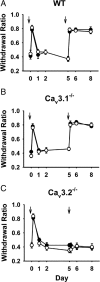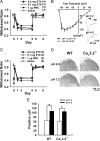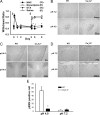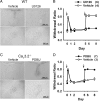Ca(v)3.2 T-type Ca2+ channel-dependent activation of ERK in paraventricular thalamus modulates acid-induced chronic muscle pain
- PMID: 20685979
- PMCID: PMC6634662
- DOI: 10.1523/JNEUROSCI.1041-10.2010
Ca(v)3.2 T-type Ca2+ channel-dependent activation of ERK in paraventricular thalamus modulates acid-induced chronic muscle pain
Abstract
Treatments for chronic musculoskeletal pain, such as lower back pain, fibromyalgia, and myofascial pain syndrome, remain inadequate because of our poor understanding of the mechanisms that underlie these conditions. Although T-type Ca2+ channels (T-channels) have been implicated in peripheral and central pain sensory pathways, their role in chronic musculoskeletal pain is still unclear. Here, we show that acid-induced chronic mechanical hyperalgesia develops in Ca(v)3.1-deficient and wild-type but not in Ca(v)3.2-deficient male and female mice. We also show that T-channels are required for the initiation, but not maintenance, of acid-induced chronic muscle pain. Blocking T-channels using ethosuximide prevented chronic mechanical hyperalgesia in wild-type mice when administered intraperitoneally or intracerebroventricularly, but not intramuscularly or intrathecally. Furthermore, we found an acid-induced, Ca(v)3.2 T-channel-dependent activation of ERK (extracellular signal-regulated kinase) in the anterior nucleus of paraventricular thalamus (PVA), and prevention of the ERK activation abolished the chronic mechanical hyperalgesia. Our findings suggest that Ca(v)3.2 T-channel-dependent activation of ERK in PVA is required for the development of acid-induced chronic mechanical hyperalgesia.
Figures





Similar articles
-
Essential role of Cav3.2 T-type calcium channels in butyrate-induced colonic pain and nociceptor hypersensitivity in mice.Eur J Pharmacol. 2020 Nov 15;887:173576. doi: 10.1016/j.ejphar.2020.173576. Epub 2020 Sep 16. Eur J Pharmacol. 2020. PMID: 32949597
-
Redox modulation of peripheral T-type Ca2+ channels in vivo: alteration of nerve injury-induced thermal hyperalgesia.Pain. 2004 Jun;109(3):328-339. doi: 10.1016/j.pain.2004.01.026. Pain. 2004. PMID: 15157694
-
Spinal protein kinase C/extracellular signal-regulated kinase signal pathway mediates hyperalgesia priming.Pain. 2018 May;159(5):907-918. doi: 10.1097/j.pain.0000000000001162. Pain. 2018. PMID: 29672451
-
Regulation of T-type calcium channels in the peripheral pain pathway.Channels (Austin). 2007 Jul-Aug;1(4):238-45. doi: 10.4161/chan.4953. Epub 2007 Oct 1. Channels (Austin). 2007. PMID: 18708751 Review.
-
Is it all central sensitization? Role of peripheral tissue nociception in chronic musculoskeletal pain.Curr Rheumatol Rep. 2010 Dec;12(6):448-54. doi: 10.1007/s11926-010-0134-x. Curr Rheumatol Rep. 2010. PMID: 20882373 Review.
Cited by
-
The analgesic effects of botulinum neurotoxin by modulating pain-related receptors; A literature review.Mol Pain. 2024 Jan-Dec;20:17448069241275099. doi: 10.1177/17448069241275099. Mol Pain. 2024. PMID: 39093638 Free PMC article. Review.
-
T-Type Calcium Channels Are Required to Maintain Viability of Neural Progenitor Cells.Biomol Ther (Seoul). 2018 Sep 1;26(5):439-445. doi: 10.4062/biomolther.2017.223. Biomol Ther (Seoul). 2018. PMID: 29463073 Free PMC article.
-
Genetic Tracing of Cav3.2 T-Type Calcium Channel Expression in the Peripheral Nervous System.Front Mol Neurosci. 2017 Mar 15;10:70. doi: 10.3389/fnmol.2017.00070. eCollection 2017. Front Mol Neurosci. 2017. PMID: 28360836 Free PMC article.
-
Exploring the role of spinal astrocytes in the onset of hyperalgesic priming signals in acid-induced chronic muscle pain.PNAS Nexus. 2024 Aug 30;3(9):pgae362. doi: 10.1093/pnasnexus/pgae362. eCollection 2024 Sep. PNAS Nexus. 2024. PMID: 39228816 Free PMC article.
-
Alleviation of neuropathic pain by regulating T-type calcium channels in rat anterior cingulate cortex.Mol Pain. 2015 Mar 6;11:7. doi: 10.1186/s12990-015-0008-3. Mol Pain. 2015. PMID: 25885031 Free PMC article.
References
-
- Altier C, Zamponi GW. Targeting Ca2+ channels to treat pain: T-type versus N-type. Trends Pharmacol Sci. 2004;25:465–470. - PubMed
-
- Bernard JF, Peschanski M, Besson JM. A possible spino (trigemino)-ponto-amygdaloid pathway for pain. Neurosci Lett. 1989;100:83–88. - PubMed
-
- Bhave G, Karim F, Carlton SM, Gereau RW., 4th Peripheral group I metabotropic glutamate receptors modulate nociception in mice. Nat Neurosci. 2001;4:417–423. - PubMed
-
- Bullitt E. Expression of c-fos-like protein as a marker for neuronal activity following noxious stimulation in the rat. J Comp Neurol. 1990;296:517–530. - PubMed
Publication types
MeSH terms
Substances
LinkOut - more resources
Full Text Sources
Other Literature Sources
Medical
Molecular Biology Databases
Miscellaneous
